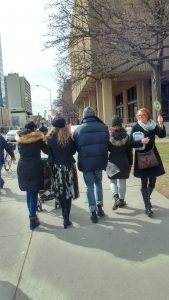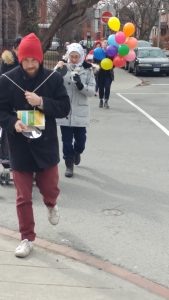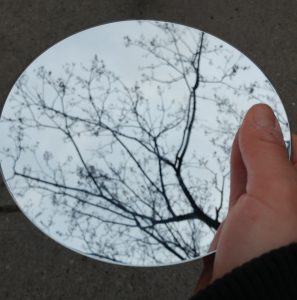“Considered no longer as a bounded, concrete site, the field exists instead as a distributed space of things, relations and bodies. And in turn, fieldwork is no longer conceived solely through the logics of extraction and recovery; rather, it is an enactive, performative process, one in which data are generated through ongoing tentative experiment as much as they are discovered or revealed.” (McCormack, p. 40)
 On a bright and breezy Thursday afternoon our Walking Methodologies class set out to experience McCormack’s description of the field. Carrying/wearing/using our altered gaits, we challenged social constructs such as “personal space” ad “normative public behaviour” by performing propositions as suggested by our Professor. We walked 3-legged, back-to-balk, backwards directed by our partners, s
On a bright and breezy Thursday afternoon our Walking Methodologies class set out to experience McCormack’s description of the field. Carrying/wearing/using our altered gaits, we challenged social constructs such as “personal space” ad “normative public behaviour” by performing propositions as suggested by our Professor. We walked 3-legged, back-to-balk, backwards directed by our partners, s ilently as one large mass and staring into small round mirrors as we navigated the sidewalks around 252 Bloor Street West. Enacting these propositions felt like an experiment where the binary of subject/object intersected. Passersby stopped and stared at us, puzzled by our movements or objects that we chose as our altered gait. Shocked faces stared intrigued by what appeared to be a spontaneous parade to a birthday party complete with balloons and cake! Some laughed, some shouted the inevitable catcall. We were a scene to be seen. The spectators’ puzzlement, presence and inadvertent participation (bodies as obstacles to avoid) felt necessary as we continued walking down the street, listening or watching for propositional cues. The experience mimicked the ascent experiments by Henry Coxwell and James Glashier in 1862 where “scientific experiment was an endeavor performed in public and, in turn, that public witnessing was an important element of what rendered these experiments legitimate” (p.43).
ilently as one large mass and staring into small round mirrors as we navigated the sidewalks around 252 Bloor Street West. Enacting these propositions felt like an experiment where the binary of subject/object intersected. Passersby stopped and stared at us, puzzled by our movements or objects that we chose as our altered gait. Shocked faces stared intrigued by what appeared to be a spontaneous parade to a birthday party complete with balloons and cake! Some laughed, some shouted the inevitable catcall. We were a scene to be seen. The spectators’ puzzlement, presence and inadvertent participation (bodies as obstacles to avoid) felt necessary as we continued walking down the street, listening or watching for propositional cues. The experience mimicked the ascent experiments by Henry Coxwell and James Glashier in 1862 where “scientific experiment was an endeavor performed in public and, in turn, that public witnessing was an important element of what rendered these experiments legitimate” (p.43).
Our experiments  in public, watched/gawkd at by strangers brought, for me, feelings of self-consciousness. However, as we continued and focused on enacting our propositions with
in public, watched/gawkd at by strangers brought, for me, feelings of self-consciousness. However, as we continued and focused on enacting our propositions with
our altered gaits those feelings subsided. My altered gait – a blue 25-pound kettle shaped weight – was no longer an object of embarrassment but instead a physical burden. I both literally and figuratively felt weighed down. Carrying it in my backpack as we walked holding small round mir
rors, I could feel it hit the back of my spine if I stopped suddenly, or moved too quickly. Changing the position of the mirror facing the sky and looking straight down forced me to walk carefully, preventing the weight from jabbing me in the back. Gazing into the mirror at the blue/grey sky, branches poking in and out of my field of vision, I began to feel weightless. The weight no longer a burden, now my connection to the earth. And in my hand I held a piece of the sky.
McCormack, D. (2010). Fieldwork with atmospheric bodies. Performance Research, 51 (4), 40-48